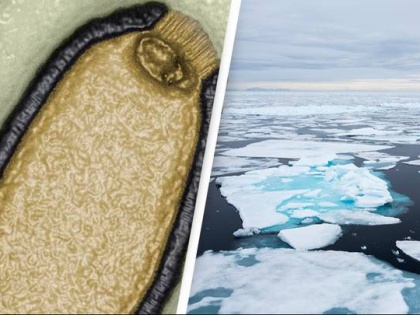'Zombie Virus' Buried in Ice Likely to Trigger Next Pandemic after Covid-19
By Lokmat English Desk | Published: January 23, 2024 06:53 PM2024-01-23T18:53:32+5:302024-01-23T18:54:38+5:30
Scientists have warned about the dangers posed by viruses buried under ice caps in the Arctic and other places. ...

'Zombie Virus' Buried in Ice Likely to Trigger Next Pandemic after Covid-19
Scientists have warned about the dangers posed by viruses buried under ice caps in the Arctic and other places. They have stated that the melting Arctic permafrost could release the 'zombie viruses' and trigger a catastrophic global health emergency, as per a report in The Guardian. The threat has increased since rising temperatures due to global warming started melting the frozen ice. To better understand the risks associated with these viruses, a scientist revived some of them from samples taken from Siberian permafrost last year. These viruses have spent thousands of years frozen in the ground.
Geneticist Jean-Michel Claverie of Aix-Marseille University said, "At the moment, analyses of pandemic threats focus on diseases that might emerge in southern regions and then spread north. By contrast, little attention has been given to an outbreak that might emerge in the far north and then travel south - and that is an oversight, I believe. There are viruses up there that have the potential to infect humans and start a new disease outbreak."Further, scientist Marion Koopmans of the Erasmus Medical Center in Rotterdam agreed with the same and added, "We don't know what viruses are lying out there in the permafrost but I think there is a real risk that there might be one capable of triggering a disease outbreak - say of an ancient form of polio. We have to assume that something like this could happen.
Despite being buried in permafrost for thousands of years, live viruses could still infect single-celled creatures, as demonstrated by a team of scientists led by Claverie in Siberia in 2014. Additional investigation, which was published the previous year, identified several virus strains from seven distinct Siberian locations and demonstrated their ability to infect cultured cells. A virus sample dated back 48,500 years. "The viruses we isolated were only able to infect amoebae and posed no risk to humans. However, that does not mean that other viruses - currently frozen in the permafrost - might not be able to trigger illnesses in humans. We have identified genomic traces of poxviruses and herpesviruses, which are well-known human pathogens, for example," said Ms Claverie.It is to be noted that a fifth of the Northern Hemisphere is covered in permafrost, which has long supported the Arctic tundra and boreal forests of Alaska, Canada and Russia. Together with ancient viruses, it acts as a kind of time capsule, preserving the mummified remains of several extinct creatures. The region is heating up several times faster than the average rate of increase in global warming, according to meteorologists. "The danger comes from another global warming impact: the disappearance of Arctic sea ice. That is allowing increases in shipping, traffic and industrial development in Siberia. Huge mining operations are being planned, and are going to drive vast holes into the deep permafrost to extract oil and ores. The potential calamitous effects could begin when miners may breathe in these viruses, accelerating a global health risk, warned the scientists.
Open in app